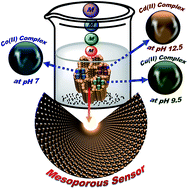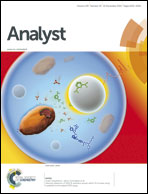Monolithic scaffolds for highly selective ion sensing/removal of Co(ii), Cu(ii), and Cd(ii) ions in water†
Abstract
High exposure to metals, such as cobalt (Co), copper (Cu) and cadmium (Cd), potentially has adverse effects, and can cause severe health problems, leading to a number of specific diseases. This study primarily aims to monitor, detect, separate, and remove the trace concentrations of Co(II), Cu(II), and Cd(II) ions in water, without a preconcentration process, using aluminosilica optical sensor (ASOS) monoliths. These monolithic scaffolds with advantageous physical features (i.e., large surface area-to-volume ratios of the scaffolds, active acid sites and uniform mesocage cubic pores) can strongly induce H-bonding and dispersive interactions with organic chelating agent, resulting in the formation of stable ASOS. In this engineering process, ASOS offers a simple and one-step sensing/capture procedure for the quantification and visual detection of the target elements from water, without requiring sophisticated instrumentation. The key result in this study is the ion selectivity exhibited by the designed ASOS toward the targets, Co(II), Cu(II), and Cd(II) ions, in environmental and waste disposal samples, as well as its reproducibility over a number of analysis/regeneration cycles. These findings can be useful in the fabrication of ASOS can be tailored to suit various applications.


 Please wait while we load your content...
Please wait while we load your content...